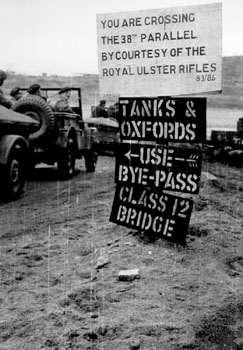

 |
 |
 |
On 4 January 1952, the BUNC received its first battle honour, for the battles it fought
on the Imjin River. Translated, the citation reads :
The BUNC received two more unit citations for these battles : the
US Presidential Unit Citation and the Korean Republic's Presidential Unit Citation. |
 |
 |
The Imjin Battles (20 - 25 April 1951)

At daybreak on 23 April, the enemy doubles its attacks on C-company's positions and manages to push back one of the platoons. Its platoon leader is heavily wounded but brought back from no-mans land (2). Despite the furious attacks, C-company stands fast. Meanwhile, the patrol sent out to secure the bridges in the rear, finds them to be controlled by the Chinese. A determined attempt to clear the area fails (3) and the battalion's supply route is cut. C-company, lead by Lt. Janssens, continues to defend itself heroically (4). Around noon the BUNC is advised that a retreat will be ordered but is requested to maintain in its position in the line to allow the neighbouring 65th Infantry to withdraw first. At 17.15 h the order to withdraw is received and the bulk of the battalion proceeds to extricate itself methodically and to wade across the Imjin River while air strikes with napalm on the abandoned positions screen the retreat. The rolling stock of some 80 vehicles, covered by two platoons of tanks sent up for the purpose, take the road across the bridges which are still under enemy control and succeed to make their withdrawal without loss of life. As night falls, the entire battalion is safely installed in its rear area.

In the morning of 25 April, however, intense enemy activity is reported on the western road by a patrol of A-company and a devastating barrage of mortar fire is directed on these enemy units. Shortly after, however, orders are received to retreat and take up new positions near Hansansang-Ni to cover the withdrawal of the Northumberland Fuseliers and the Royal Ulster Rifles. B-company is detached for the protection of the Brigade's Command Post but a troop of 3 Centurion tanks is attached to the battalion in return. Around 12.30 h the enemy takes up positions on Hill 191 and directs heavy fire on the battalion. Shortly after, at about 13.00 h, C-company's position is plastered with artillery and it withdraws south of the road (5 & 6). Around 14.00 h the Ulsters and Northumberlands have sufficiently retreated for the BUNC to receive their withdrawal order and while fighting rearguard actions the battalion slowly retreats. The battalion will finally regroup at Tokchong at 17.00 h and take up positions covering the road to Seoul until replaced in the line at midnight.
In the course of these battles, the 29th Brigade, attached to the US 3rd Division, was attacked by the Chinese 63th Army consisting of 3 divisions, each about 8,000 strong. The Brigade, some 4,000 strong, thus faced a 6-fold enemy majority. The allies eventually halted the Chinese offensive and counterattacks drove the enemy back to their original positions north of the Imjin River.
 |
 |
 |
 |
 |
 |
 |
 |
 |
Copyright Hendrik Meersschaert 2024 ©